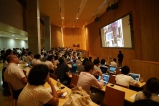2018年7月10日、福武ラーニングシアターにて情報学環「ヒューマンオーグメンテーション学(ソニー寄付講座)」の第三回セミナーが開催されました。昨年の第一回セミナーのテーマである「知覚の拡張」に続き、今回は「身体能力の拡張」というテーマのもと三名の識者による講演および情報学環教授の暦本純一を交えたパネルディスカッションが行われ、学生や社会人を合わせ約200名が参加しました。
東京大学の中澤公孝教授による講演では、パラリンピックアスリートの卓越した身体能力を実現する脳の可塑性について研究紹介が行われ、臨床応用としてのニューロリハビリテーションの可能性についても議論がなされました。また、ソニーコンピュータサイエンス研究所研究員の古屋晋一氏による講演では、医学的知見及び工学技術を活用してピアニストの音楽表現を支援する氏の取り組みが紹介されました。同講座の味八木崇特任准教授による講演では、身体的な技能獲得の支援・身体能力の拡張に関する暦本研究室の研究実績が紹介されました。
パネルディスカッションでは上記三名に加え情報学環の暦本純一教授も参加し、身体的技能獲得における練習の重要性や今後の工学分野の進展に対する期待などについて意見が交換されました。セミナー全体を通して、医学生理学の視座に基づいた身体能力の拡張可能性について多く議論が行われ、ヒューマンオーグメンテーション学を切り拓くにあたっての学際的協働の重要性が改めて裏付けられるものとなりました。
記事・写真:野澤 和徳(修士課程)
On July 10, 2018, the 3rd seminar of “Human Augmentation (endowed
chair by Sony)” was held at Fukutake Learning Theater. Following the “augmentation of perception,” which was held up as a major topic in the 1st seminar last year, this time we held up “augmentation of physical abilities” as a topic. Three experts gave lectures and held panel discussions along with Prof. Jun Rekimoto of the III. Around 200 students and workers participated in the seminar.
In his lecture, Prof. Kimitaka Nakazawa of the University of Tokyo introduced the latest research into the plasticity of the brain Paralympics athletes have, and he discussed the possibility of neurorehabilitation as a clinical application. Dr. Shinichi Furuya of Sony Computer Science Laboratories presented his research on the use of medical knowledge and engineering methodologies to support musical expressions by pianists. Project Associate Prof. Miyaki Takashi of the III introduced research in Rekimoto Lab regarding augmentation of physical abilities and support of skill acquisition.
In the panel discussions, Prof. Jun Rekimoto of the III also participated, and they discussed a variety of topics such as the
importance of practice in skill acquisition and the expectancy of future advances in engineering. Throughout the seminar, many discussions revolved around the possibility of augmenting physical abilities from the medical and physiological perspectives, which corroborated the importance of interdisciplinary cooperation in opening up the Human Augmentation studies.
Text and Photo: Kazunori Nozawa (MA student)



